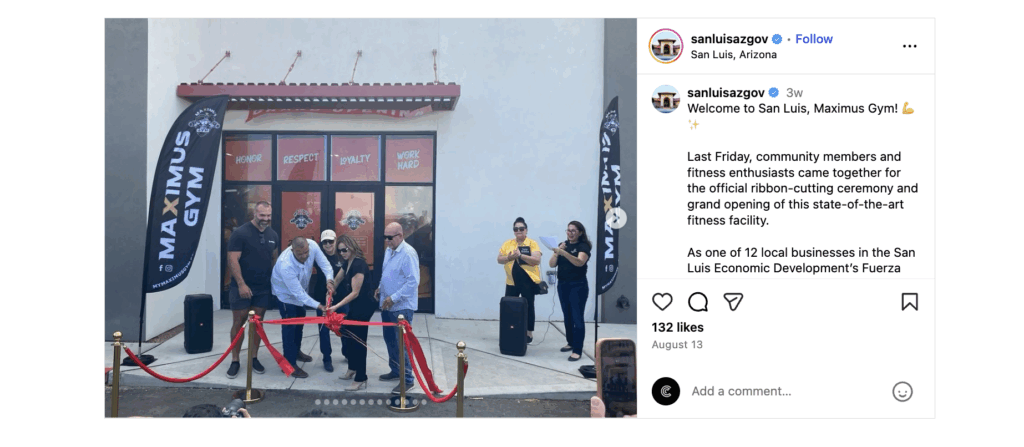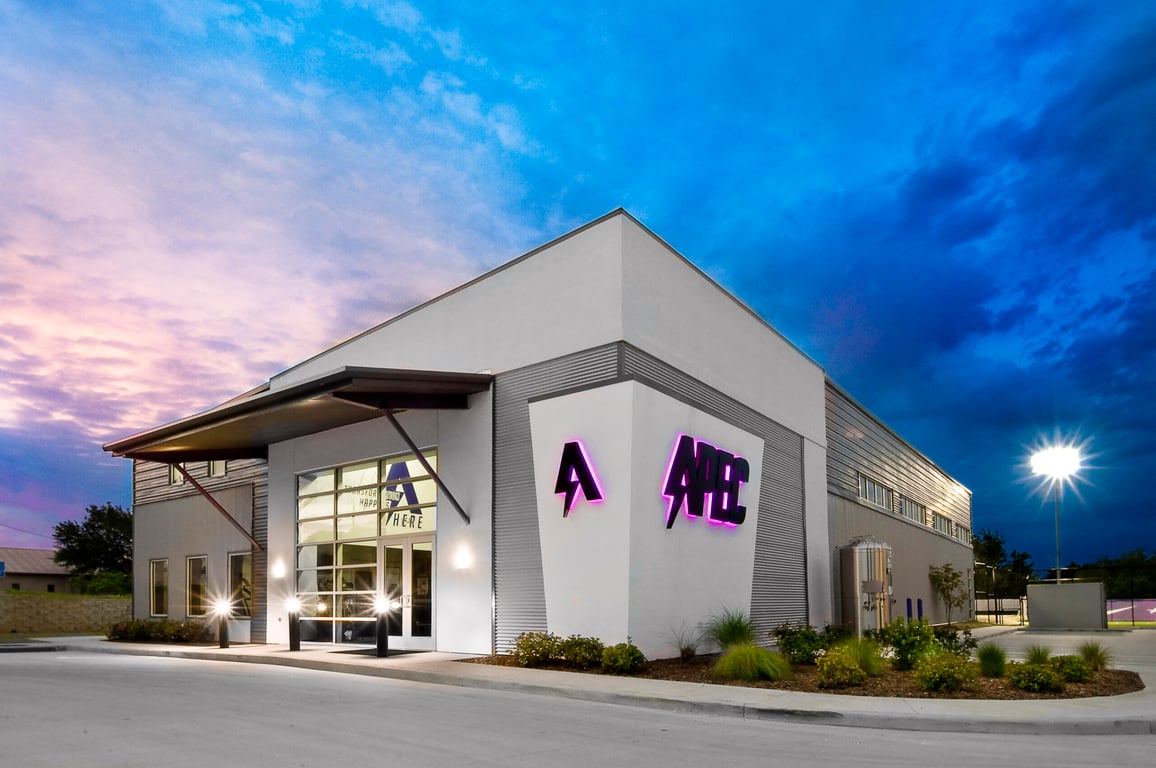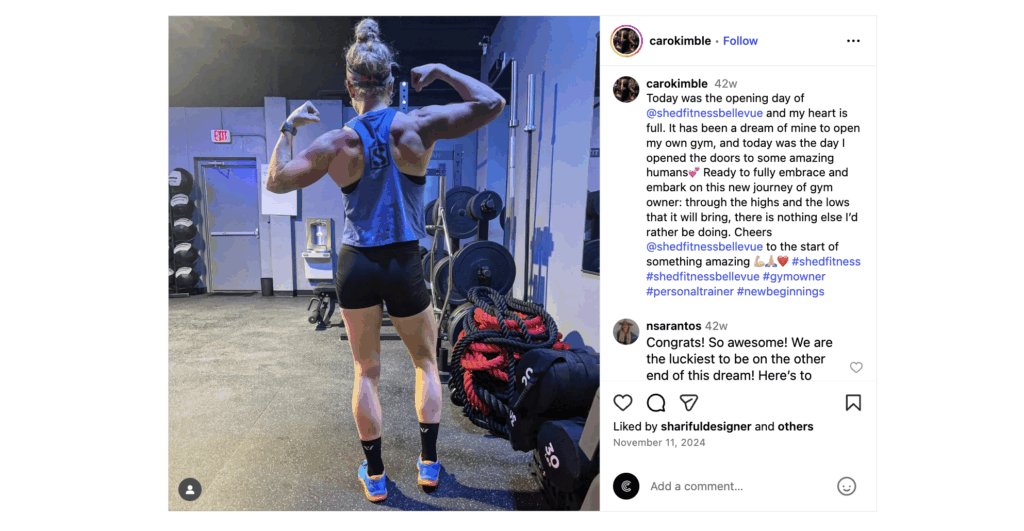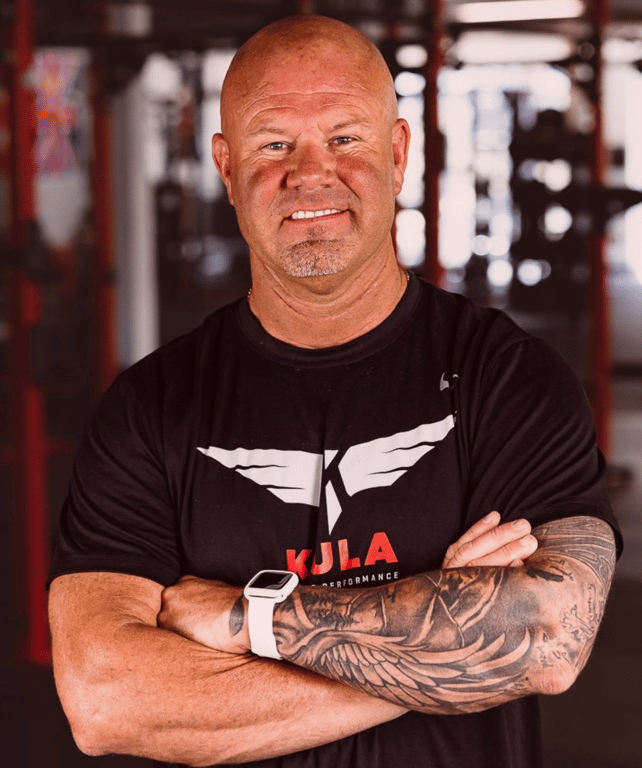Platform
Solutions
Industries
Compare
Resources
Posted by on January 24, 2024 — Updated on September 26, 2025
The cost to build a commercial gym facility from the ground up can range from $200,000 on the low end to $5,000,000 or more on the high end. Learn the true cost of opening a gym facility, and how to run it smarter with Exercise.com.
When you decide to open a gym, one of the most important costs to open a gym include the decision to either lease an existing building or build your own gym building from the ground up. Building a gym from the ground up involves a substantial investment, as it encompasses construction costs, interior fittings, equipment, and operational setup. The total commercial gym facility cost can vary widely based on location, size of the facility, and the level of gym features and amenities you plan to include. Learn what drives gym build out costs and how to protect your investment using Exercise.com’s all-in-one software.

Prospective gym owners who want to open a gym should plan for substantial initial cost to build a gym facility and have a gym budget in place before beginning a gym construction project (learn how to create a gym budget, how to create a gym sales forecast, how to negotiate a gym lease, how to get the best gym insurance, how to reduce gym overhead expenses, and how to get a gym loan with our free guides).
See the below approximate overall commercial gym facility construction cost estimate for each type of gym:
| Cost Category | Small/Boutique Gym | Mid-Size Gym | Large Commercial Gym |
|---|---|---|---|
| Land Acquisition | $50,000 – $200,000 | $200,000 – $500,000 | $500,000 – $1,000,000+ |
| Construction Costs | $100,000 – $500,000 | $500,000 – $1,000,000 | $1,000,000 – $4,000,000+ |
| Architectural and Design Fees | $5,000 – $25,000 | $25,000 – $50,000 | $50,000 – $200,000 |
| Gym Equipment | $10,000 – $50,000 | $50,000 – $100,000 | $100,000 – $500,000 |
| Interior Fittings and Finishings | $10,000 – $40,000 | $20,000 – $60,000 | $40,000 – $100,000 |
| Utilities and Maintenance | $2,000 – $5,000/month | $5,000 – $10,000/month | $10,000 – $20,000/month |
| Insurance | $1,000 – $5,000/year | $5,000 – $10,000/year | $10,000 – $20,000/year |
| Staffing | $30,000 – $100,000/year | $100,000 – $200,000/year | $200,000 – $500,000/year |
| Marketing and Advertising | $5,000 – $20,000 | $20,000 – $50,000 | $50,000 – $100,000 |
| Licenses and Permits | $1,000 – $5,000 | $5,000 – $10,000 | $10,000 – $20,000 |
| Total (Approximate) | $200,000 – $1,000,000+ | $800,000 – $2,000,000+ | $1,500,000 – $5,000,000+ |
The cost to build a commercial gym facility is a complex figure that varies based on multiple factors such as the type of gym, location of the gym, the gym business model, potential gym franchise costs, and whether you are planning to scale to multiple gym locations. See why using Exercise.com as your all-in-one gym management software helps you replace a confusing list of other alternative solutions.
Read on to find out more, then be sure to find out why Exercise.com is the best gym software system for gyms of all sizes who want to learn how to start a fitness business and to manage their business in one place. Compare the best gym management software and the best personal training software so you can see just what you can do on the Exercise.com platform.
Offer a premium gym member experience with amazing gym check-ins.
Easy gym payment processing.
Quick and seamless gym booking and scheduling, online and in-person.
All though your own custom-branded gym fitness app that elevates your gym’s brand, giving your gym members a consistent branded experience.
Take your gym to the next level and reward your staff with the best gym management software platform: Exercise.com.

The cost of opening a gym isn’t just about square footage and equipment—it’s about building a sustainable business model that generates ROI from day one. Depending on the location, size, and concept, your commercial gym setup cost can range anywhere from $200,000 for a smaller training studio to $1 million+ for a full-service fitness center. Beyond the space required for a commercial gym, you’ll need to budget for lease deposits, zoning fees, and buildout expenses. Our guide on the cost of opening a gym breaks down the math in detail, but the critical factor is whether your systems—billing, scheduling, member retention—can scale with your investment. That’s where Exercise.com comes in.
When projecting how much does it cost to build a commercial gym facility, operators often underestimate:
With Exercise.com, you can offset these fixed costs by maximizing ARPM through digital memberships, custom branded apps, and online coaching revenue streams that don’t require additional square footage.
A full gym equipment checklist can run anywhere from $50,000 to $300,000 depending on brand and quality. Even more important: ongoing gym equipment maintenance and replacement cycles can erode profit margins. Many operators forget to budget for this, leaving them scrambling with emergency repairs. By using gym equipment checklist templates and pairing them with software that tracks usage and depreciation, you’ll not only extend the lifespan of your assets but also protect your gym financial model.
Your facility isn’t just functional—it’s a marketing tool. Details like commercial gym wall ideas, gym entrance ideas, and commercial gym decoration ideas influence first impressions, conversion rates, and member retention. But design must be balanced with efficiency. A beautiful space that isn’t optimized for traffic flow or check-ins is a liability. Exercise.com’s best gym management software complements your design by creating a seamless member experience—from booking to billing to class engagement.
This illustrates that success isn’t just about square footage—it’s about systems.

Commercial gym owners often ask how to lower fixed costs without compromising member experience. Strategies include:
With Exercise.com, you can implement these cost-saving strategies while boosting revenue through automated billing, client tracking, and hybrid membership management.
So, how much does it cost to build a commercial gym facility? The upfront investment varies, but the bigger question is whether your systems can support profitability long term. Without robust software, even the most beautiful facility can struggle. Exercise.com provides the infrastructure to scale—streamlining member management, boosting ARPM, automating retention strategies, and opening new digital revenue streams.
If you’re preparing to launch your gym and want to ensure your investment pays off, book a demo with Exercise.com today. We’ll show you how to transform your commercial gym facility into a sustainable, profitable business.
When owners ask about the cost to build a commercial gym facility, they’re really asking: “What’s my all-in CapEx, what monthly OpEx follows, and how quickly can I reach break-even with my pricing and capacity?” Use the framework below to turn a rough idea into a financeable plan that can help you get a gym loan if needed and maximize gym profitability—and see exactly where Exercise.com removes risk and accelerates payback with better billing, bookings, door access, and member engagement.
Gym CapEx (one-time):
Gym OpEx (monthly):
For a step-by-step business planning workflow, use: How to Write a Business Plan for a Gym and the practical overview in The Cost of Opening a Gym. If CrossFit or similar functional training is your model, sanity-check with How Much Does It Cost to Build a CrossFit Box.
Before you sign anything, lock three constraints that swing cost by 20–40%:
Turn design into an ROI tool with: Commercial Gym Layout Ideas, Commercial Gym Design Ideas, Commercial Gym Decoration Ideas, Commercial Gym Wall Ideas, and front-door conversion tactics in Gym Entrance Ideas.
Helpful resources: What Equipment Is Needed to Start a Gym, Gym Equipment Checklist Template, and lifecycle care via Gym Equipment Maintenance.
Avoid landmines with: Common Gym Lease Issues to Avoid and How to Negotiate a Gym Lease.
Gym Break-Even Members = (Rent + Payroll + Utilities + Insurance + Software + Debt Service) ÷ ARPM
Model member targets with How to Open a Gym and then pressure-test with your local costs from The Cost of Opening a Gym. Validate the facility size/capacity constraints with Space Required for a Commercial Gym.
See: Ways to Reduce Gym Overhead Costs, How to Reduce Gym Utility Bills, and ops playbooks like How to Handle Gym Maintenance Issues.
CapEx misses happen when compliance is an afterthought. Budget for:
Start with: Gym Legal Guide, Gym Insurance, and staffing context in What Qualifications Do You Need to Open a Gym Business.
Execute with: Gym Open House, then keep marketing compounding in your app using Custom-Branded Apps and your broader growth engine in How to Start a Fitness Business and How to Make a Fitness App.
Lock the stack with: Best Gym Management Software, Best CRM Software for Gyms, Best Gym Software With Door Access Control, and coaching tools in Best Personal Training Software.
The real answer to “how much does it cost to build a commercial gym facility?” is your model, not a single number. Size the space from peak-hour station demand, design the layout for safety and sales, protect your budget in the lease, and run the math to break even fast with ARPM-lifting products and strict capacity rules. Exercise.com is the system that makes that plan repeatable—booking, billing, door access, CRM, and your custom app in one place—so your build turns into a profitable business, faster.
Ready to reduce risk, speed up payback, and run your entire gym on one platform? Book a demo with Exercise.com and turn your floor plan into a predictable P&L.

Building a commercial gym facility is one of the most significant investments a fitness entrepreneur will ever make. From gym zoning requirements to commercial gym layout ideas, the costs add up quickly—and mistakes in planning can derail profitability before the doors even open. Most operators underestimate expenses like common gym lease issues to avoid or the ongoing costs of gym equipment maintenance, only to find themselves struggling to achieve a sustainable gym ROI.
This is where Exercise.com changes the equation. While you focus on the physical build-out, our all-in-one platform ensures your digital infrastructure—billing automation, member retention tools, financial reporting, and custom-branded apps—is ready from day one. That way, every square foot of your facility is backed by a system designed to maximize revenue per member.
When considering how much does it cost to build a commercial gym facility, owners must factor in multiple categories of expenses:
Without clear financial forecasting, operators risk underestimating total investment. That’s why tools like the gym business plan template are essential before breaking ground.
Your physical build-out is only half the equation. Even with perfect design and equipment, if your membership systems are clunky or your billing fails, your gym financial model collapses. That’s where Exercise.com adds measurable ROI.
Our platform integrates:
The true cost of opening a gym doesn’t end at construction—it extends into member retention, profitability, and scaling. With Exercise.com, you don’t just open a gym; you launch a business model that can withstand industry volatility.
Whether you’re planning your facility with commercial gym layout ideas, negotiating a lease with how to negotiate a gym lease, or strategizing your gym open house to attract your first 200 members, the software you choose determines whether your gym thrives or struggles.
Exercise.com ensures that every dollar spent on facility build-out is supported by a digital system designed to maximize profit margins, member engagement, and operational efficiency.
Book a demo with Exercise.com today and see how we can help you turn your commercial gym investment into a scalable, profitable business.

See the below approximate overall commercial gym facility construction cost estimate for each type of gym:
| Cost Category | Small/Boutique Gym | Mid-Size Gym | Large Commercial Gym |
|---|---|---|---|
| Land Acquisition | $50,000 – $200,000 | $200,000 – $500,000 | $500,000 – $1,000,000+ |
| Construction Costs | $100,000 – $500,000 | $500,000 – $1,000,000 | $1,000,000 – $4,000,000+ |
| Architectural and Design Fees | $5,000 – $25,000 | $25,000 – $50,000 | $50,000 – $200,000 |
| Gym Equipment | $10,000 – $50,000 | $50,000 – $100,000 | $100,000 – $500,000 |
| Interior Fittings and Finishings | $10,000 – $40,000 | $20,000 – $60,000 | $40,000 – $100,000 |
| Utilities and Maintenance | $2,000 – $5,000/month | $5,000 – $10,000/month | $10,000 – $20,000/month |
| Insurance | $1,000 – $5,000/year | $5,000 – $10,000/year | $10,000 – $20,000/year |
| Staffing | $30,000 – $100,000/year | $100,000 – $200,000/year | $200,000 – $500,000/year |
| Marketing and Advertising | $5,000 – $20,000 | $20,000 – $50,000 | $50,000 – $100,000 |
| Licenses and Permits | $1,000 – $5,000 | $5,000 – $10,000 | $10,000 – $20,000 |
| Total (Approximate) | $200,000 – $1,000,000+ | $800,000 – $2,000,000+ | $1,500,000 – $5,000,000+ |
This table provides a broad approximation of the potential investment required for building a gym facility for different types of gyms. It’s important to note that these figures are estimates and actual costs can vary based on numerous factors, including specific location, design choices, and market conditions.
Here’s a rough breakdown of the primary costs:
In total, the cost to build a commercial gym facility from scratch can easily exceed several million dollars. For a modest-sized facility of about 10,000 square feet, the cost could be in the range of $1 million to $4 million, considering all the aforementioned factors. However, these are broad estimates, and actual costs will vary greatly based on specific project details, regional pricing differences, and the level of luxury or specialization of the gym.

Acquiring land is the foundational step in building a commercial gym facility. The cost of land is contingent on various factors like location, size, and zoning regulations.
Purchasing land in the right location is crucial as it not only affects the initial cost but also the potential success of the gym. It’s important to conduct thorough research and possibly consult real estate professionals to find a plot that aligns with your business goals.
Read More:
The actual construction of the building is one of the most significant expenses in creating a gym facility.
Construction costs need careful planning and budgeting. It’s advisable to get quotes from several contractors and to have a contingency budget for unforeseen expenses that often arise during construction.
Professional fees for architects and designers are crucial for a well-planned gym facility.
Investing in quality architectural and interior design services can significantly impact the functionality and appeal of your gym, potentially increasing its long-term success.
Read More:
Equipping your gym with the right machinery and accessories is a major expense that will vary based on the quality and quantity of equipment.
Quality equipment is a significant investment but is essential for attracting and retaining members. It’s also a key factor in the overall perception of your gym’s brand.
Read More:
The interior fittings and finishings play a vital role in the overall look and feel of your gym.
The interior design of your gym should not only be aesthetically pleasing but also functional and durable, considering the high-traffic nature of the facility. This aspect of the gym greatly influences member experience and satisfaction. These aspects form the foundational expenses in building a commercial gym. Each requires careful consideration and planning to ensure that the final facility meets both business objectives and client expectations.
Read More:
Setting up and maintaining utilities is an essential, ongoing cost for a commercial gym.
Utilities and maintenance are critical for creating a comfortable and safe environment for gym goers. Regular maintenance not only prolongs the life of the equipment but also helps in avoiding costly repairs or replacements in the future.
Read More:
Insurance is a vital component in protecting your gym business against potential liabilities.
Selecting the right insurance coverage ensures that your gym is safeguarded against unforeseen circumstances, thereby securing your investment and business continuity.
Read More:
Hiring qualified staff is crucial for the successful operation of a commercial gym.
Staff costs are a significant part of your operating budget, but skilled and friendly staff are essential for customer satisfaction and retention.
Read More:
Effective marketing and advertising strategies are crucial for attracting members to your new gym.
Investing in marketing and advertising not only helps in building brand awareness but also drives membership sales, which are crucial for the gym’s long-term success.
Read More: Gym Marketing Ideas
Obtaining the necessary licenses and permits is a critical step in setting up a gym.
While these costs may not be as high as others, they are essential for legally operating your gym and maintaining compliance with local regulations.
Read More: Commercial Gym Punch List Template
Each of these components plays a crucial role in the successful creation and operation of a commercial gym. While the initial investment may be substantial, meticulous planning and management can lead to a profitable and sustainable fitness business.
Owning a gym can be quite profitable, with average annual profits ranging from $20,000 to $100,000 and above for well-managed facilities. Success hinges on factors like location, gym size, membership fees, and operational efficiency. Exercise.com’s software enhances profitability by streamlining management tasks and improving member engagement.
Read More: How profitable is owning a gym?
The cost to build a commercial gym typically ranges from $50,000 to several hundred thousand dollars, depending on the gym’s size, location, and the type of equipment and amenities offered. Exercise.com can assist in reducing operational costs through efficient gym management software.
Starting a gym requires capital ranging from $10,000 to $50,000 for a small, basic gym, and up to $500,000 or more for a larger facility with high-end equipment and amenities. Budgeting should account for equipment, rental space, staff salaries, and marketing.
To build your own commercial gym:
Opening a gym can be a good investment if it’s well-planned and managed. The fitness industry shows resilience and growth potential, but success depends on factors like location, market research, and effective management, for which Exercise.com’s software can be a valuable asset.
Opening a gym can be worth it if you have a clear business strategy, understand your target market, and are prepared for the initial financial commitment and ongoing operational demands. Utilizing management tools like those offered by Exercise.com can significantly contribute to a gym’s success and worth.
For a gym, you need several types of insurance, including general liability, professional liability, property insurance, and workers’ compensation. These cover various risks associated with operating a fitness facility, from equipment damage to client injuries.
Read More: What insurance do I need for a gym?
Owning a small gym can yield profits ranging from $1,000 to $5,000 per month, depending on factors like location, membership fees, operational efficiency, and services offered. Implementing a robust gym management system like Exercise.com can enhance profitability through improved member retention and streamlined operations.
Read More: Gym Owner Average Salary
A good size for a commercial gym typically ranges from 3,000 to 10,000 square feet. This size allows for a variety of equipment and spaces for different workout zones, such as cardio, strength training, group classes, and personal training areas.
Read More: What is a good size for a commercial gym?
Owning a gym can be challenging, involving tasks like managing finances, staff, member retention, and facility maintenance. However, with effective planning, strong marketing strategies, and the use of comprehensive gym management tools like Exercise.com, these challenges can be successfully navigated.
Read More: Pros and Cons of Owning a Gym
Starting a gym business isn’t necessarily easy and requires careful planning, market research, substantial capital, and dedication. However, it can be made more manageable with the use of resources and tools like Exercise.com, which streamline business operations and member management.
To start a gym, essential equipment includes cardiovascular machines (treadmills, ellipticals, bikes), strength training equipment (free weights, resistance machines), functional fitness gear (kettlebells, medicine balls), and space for stretching and group classes.
Read More: What equipment is needed to start a gym?
To open a yoga studio:
Read More: How to Open a Yoga Studio
The best brand for gym equipment often depends on specific needs and budgets, but popular choices include Life Fitness, Precor, Rogue Fitness, and Technogym, known for their quality, durability, and range of products.
Yes, commercial gyms can make money. Their profitability depends on factors like membership rates, operational efficiency, the range of services offered, and effective marketing. Successful gyms typically have a strong member base and manage expenses well.
Read More: How do gyms make money?
Starting a gym business with no money is challenging but possible by:
Read More: How to Start a Gym with No Money
Commercial gyms can be cheaper to join compared to boutique studios due to their scale. They often offer a wide range of amenities and services at competitive prices, attracting a broader member base.
The success rate of gyms varies, but generally, around 60% of gyms and fitness studios can survive the first few years. Success rates improve with effective business strategies, strong customer service, and efficient operational management.
Read More: Reasons Gyms Fail
The toughest thing about being a gym owner is managing the multiple aspects of the business, including finances, staff management, member retention, and keeping up with industry trends. Overcoming these challenges often requires a comprehensive approach and the use of effective tools like Exercise.com.
Read More: What challenges do gym owners face?
Exercise.com can help run a successful gym business by providing a comprehensive platform for managing all aspects of your gym. This includes member management, scheduling, billing, reporting, and creating custom-branded apps for member engagement. Its versatile software streamlines operations, enhances member experience, and ultimately contributes to increased efficiency and profitability.
 Tyler Spraul
Tyler Spraul 




